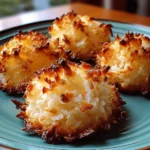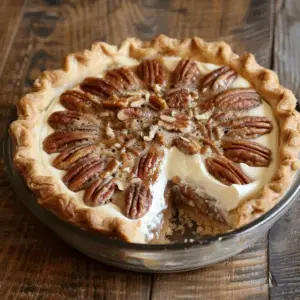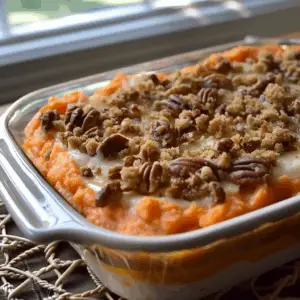Coconut macaroons are a beloved treat known for their chewy texture, lightly crisped edges, and rich coconut flavor. With minimal ingredients and simple preparation, they make an ideal dessert for both novice bakers and seasoned pastry lovers. This first-place coconut macaroon recipe stands out for its perfect balance of sweetness, texture, and flavor — a combination that has earned it top accolades in baking competitions and home kitchens alike.
Macaroons are often mistaken for the more delicate French macarons, but they’re very different in structure and taste. While macarons are sandwich cookies made from almond flour and filled with ganache or jam, macaroons are dense, chewy mounds made primarily of shredded coconut. You’ll discover that this recipe, made with just a few pantry staples, is not only award-winning but incredibly easy to master. It’s the perfect go-to cookie for holidays, bake sales, and sweet cravings any time of year.
Understanding what makes these cookies so special requires looking at both tradition and science. From the role of egg whites to how shredded coconut affects texture, every element of this recipe has purpose. You can explore more about the role of egg whites in baking and how they help create structure and lift in meringue-based cookies like macaroons. In addition, learning about shredded coconut can give insight into why it’s the key texture component in this dessert.
🍪 What are coconut macaroons?
Coconut macaroons are drop cookies made from a simple combination of sweetened shredded coconut, sugar, egg whites, and a touch of vanilla extract. Unlike many baked goods, macaroons are naturally gluten-free and dairy-free (as long as no condensed milk is used), making them accessible to people with common dietary restrictions. They are beloved for their crunchy exterior and moist, chewy interior.
One major point of confusion often lies in the difference between macarons and macaroons. Though the names sound nearly identical, the two desserts are vastly different. Cookies like macaroons are more rustic and hearty, while macarons are delicate and refined. This contrast lies not only in ingredients but also in method.
Additionally, macaroons are especially popular during Jewish holidays like Passover due to their flourless composition. Their adaptability and ease of customization make them a staple for festive occasions and quick dessert solutions. For a more in-depth dive into coconut as an ingredient, check out the history and uses of coconut.
If you’re seeking inspiration for more variations, Pinterest’s collection of coconut macaroon ideas offers endless creativity—from chocolate-dipped versions to macaroons with fruit or citrus zest.
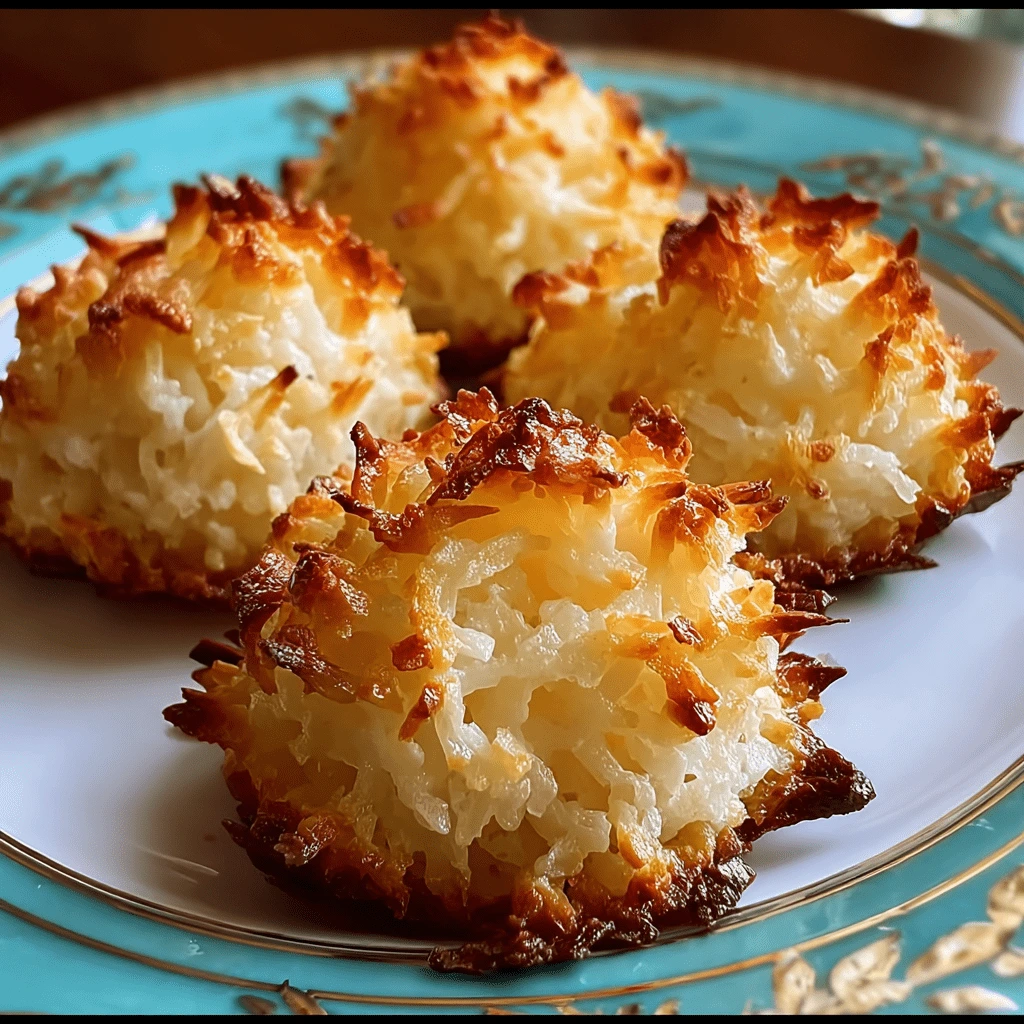
🌟 Why you’ll love this first-place recipe
There are countless reasons to fall in love with this first-place coconut macaroon recipe, whether you’re baking for yourself or for others. Here are just a few standouts:
-
Simplicity: Only seven common pantry ingredients
-
No fancy equipment: Just a bowl and a spoon
-
Quick prep time: From bowl to oven in under 10 minutes
-
Perfect texture: Crispy outside, chewy center
-
Naturally gluten-free: Safe for many dietary needs
This recipe works beautifully for everything from last-minute desserts to gourmet cookie platters. It’s a no-fuss, high-reward recipe that’s earned top honors in baking contests for a reason.
🧂 Ingredients breakdown
Let’s take a closer look at each of the ingredients and their purpose in this award-winning coconut macaroon recipe.
✅ Ingredients list:
-
1 1/3 cups sweetened shredded coconut
-
1/3 cup sugar
-
2 tablespoons all-purpose flour
-
1/8 teaspoon salt
-
2 large egg whites
-
1/2 teaspoon vanilla extract
✅ Ingredient functions:
-
Sweetened shredded coconut: The star ingredient, it gives the macaroons their iconic chewy texture and rich tropical flavor. Learn more about shredded coconut.
-
Sugar: Adds sweetness and helps the cookies brown during baking.
-
All-purpose flour: Acts as a binder to help hold the cookies together and give them just enough structure. Read more about all-purpose flour here.
-
Salt: Balances the sweetness and enhances flavor.
-
Egg whites: Help bind the ingredients and create the signature chewy texture. Explore egg white science.
-
Vanilla extract: Adds aroma and depth. Learn about vanilla extract and its essential role in baking.
If you’re avoiding gluten, you can easily substitute the all-purpose flour with almond flour or a 1:1 gluten-free flour blend. For a sugar-free version, use a granulated stevia or monk fruit sweetener.
🔪 Step-by-step instructions
Mastering this first-place coconut macaroon recipe is a breeze. With just a few careful steps, you’ll create beautifully golden, chewy cookies that look and taste like they came from a professional bakery.
✅ Instructions:
-
Preheat your oven to 325°F (163°C). This moderate temperature ensures even baking without burning the coconut.
-
Grease a baking sheet or line with parchment paper to prevent sticking. Learn more about the function of baking sheets in even heat distribution.
-
In a large mixing bowl, combine the sweetened shredded coconut, sugar, flour, and salt. Mix thoroughly to distribute the dry ingredients evenly.
-
In a separate bowl, lightly beat the egg whites and vanilla extract until just combined. No need to whip to stiff peaks.
-
Add the egg white mixture to the dry ingredients, stirring until everything is well combined and moistened.
-
Using a teaspoon or small cookie scoop, drop rounded mounds of the mixture onto the prepared baking sheet. Leave about 1 inch between each for even cooking.
-
Bake for 18–20 minutes, or until the tops are golden brown and edges are lightly crisped.
-
Remove from oven and cool completely on a wire rack to preserve their chewy centers.
These cookies are best enjoyed the same day, but they store beautifully as well.
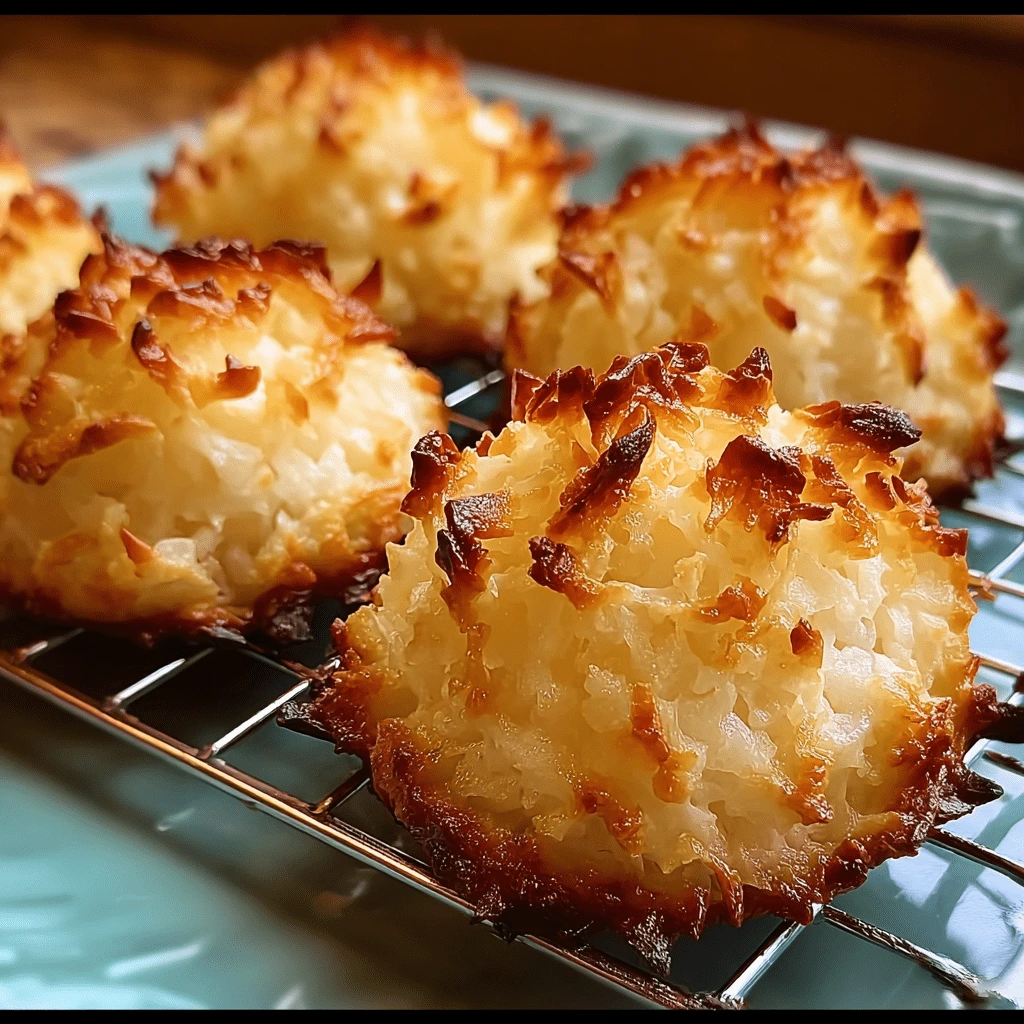
🧁 Customizing your coconut macaroons
Once you’ve mastered the base recipe, you can take your coconut macaroons to the next level with a few delicious customizations. These ideas are inspired by top-rated recipes on Pinterest.
✅ Flavor and texture upgrades:
-
Chocolate drizzle or dip: Dip the bottoms in melted dark or semi-sweet chocolate for added richness.
-
Add nuts: Chopped almonds, pecans, or walnuts add crunch and complexity.
-
Fruit twist: Fold in finely chopped dried cranberries, cherries, or pineapple.
-
Zesty flavors: Add 1 tsp of lemon or orange zest to brighten the flavor.
-
Extract swap: Replace vanilla extract with almond or coconut extract for a bolder taste.
These variations can transform the simple macaroon into a show-stopping treat worthy of gift boxes or dessert buffets.
⚠️ Common mistakes and how to avoid them
Even though this recipe is simple, a few common mistakes can affect the final results. Here’s how to troubleshoot:
❌ Problem: Cookies are too flat or spread too much
Fix: The mixture was likely too wet. Ensure you’re using properly measured shredded coconut and don’t overmix the batter.
❌ Problem: Cookies are too dry
Fix: Overbaking is a common issue. Remove from the oven as soon as the tops turn golden brown.
❌ Problem: Cookies fall apart
Fix: This usually means there’s not enough binding. Don’t skip the flour, and make sure egg whites are evenly distributed.
For more coconut-based dessert tips, check out gluten-free coconut dessert ideas on Pinterest.
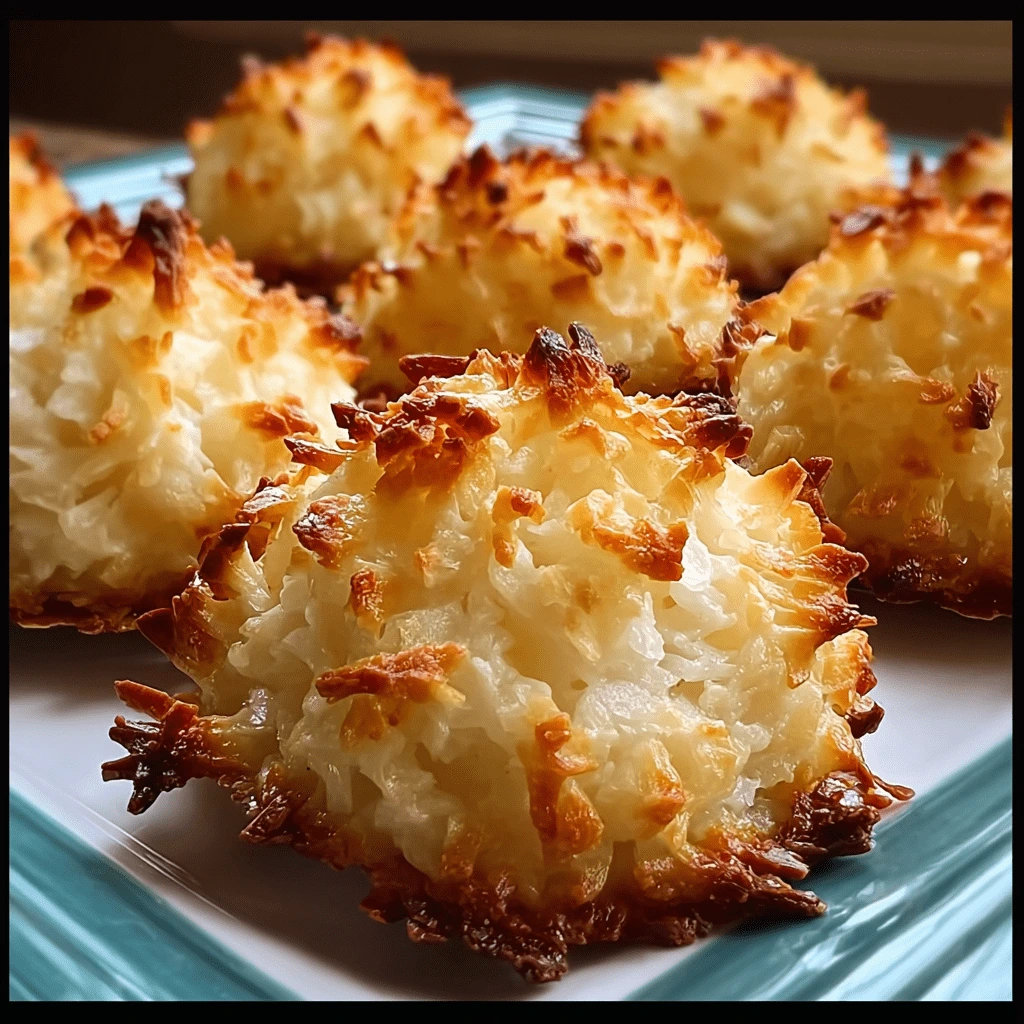
🧊 How to store coconut macaroons
Proper storage will keep your macaroons fresh and chewy for days. Here’s how to do it right:
✅ At room temperature:
-
Store in an airtight container for up to 5 days.
-
Use parchment between layers to avoid sticking.
✅ In the refrigerator:
-
Keeps for up to 10 days.
-
Allow to return to room temp before serving for best texture.
✅ In the freezer:
-
Freeze in a single layer, then transfer to a sealed bag.
-
Lasts up to 3 months.
-
Re-crisp in a 300°F oven for 5–7 minutes after thawing.
Check out more storage tips and creative cookie ideas on Pinterest cookie boards.
🎉 Serving ideas and occasions
Macaroons are one of the most versatile cookies you can make. They fit a variety of celebrations and occasions, from casual to elegant.
✅ Serve them:
-
On a holiday cookie tray with sugar cookies and brownies
-
As part of a wedding dessert bar
-
With coffee or tea as a simple afternoon treat
-
Wrapped in cellophane for homemade gifts
-
As a gluten-free option in dessert spreads
These cookies also pair beautifully with tropical flavors, so consider serving them alongside fresh pineapple or mango sorbet for a summer-themed dessert.
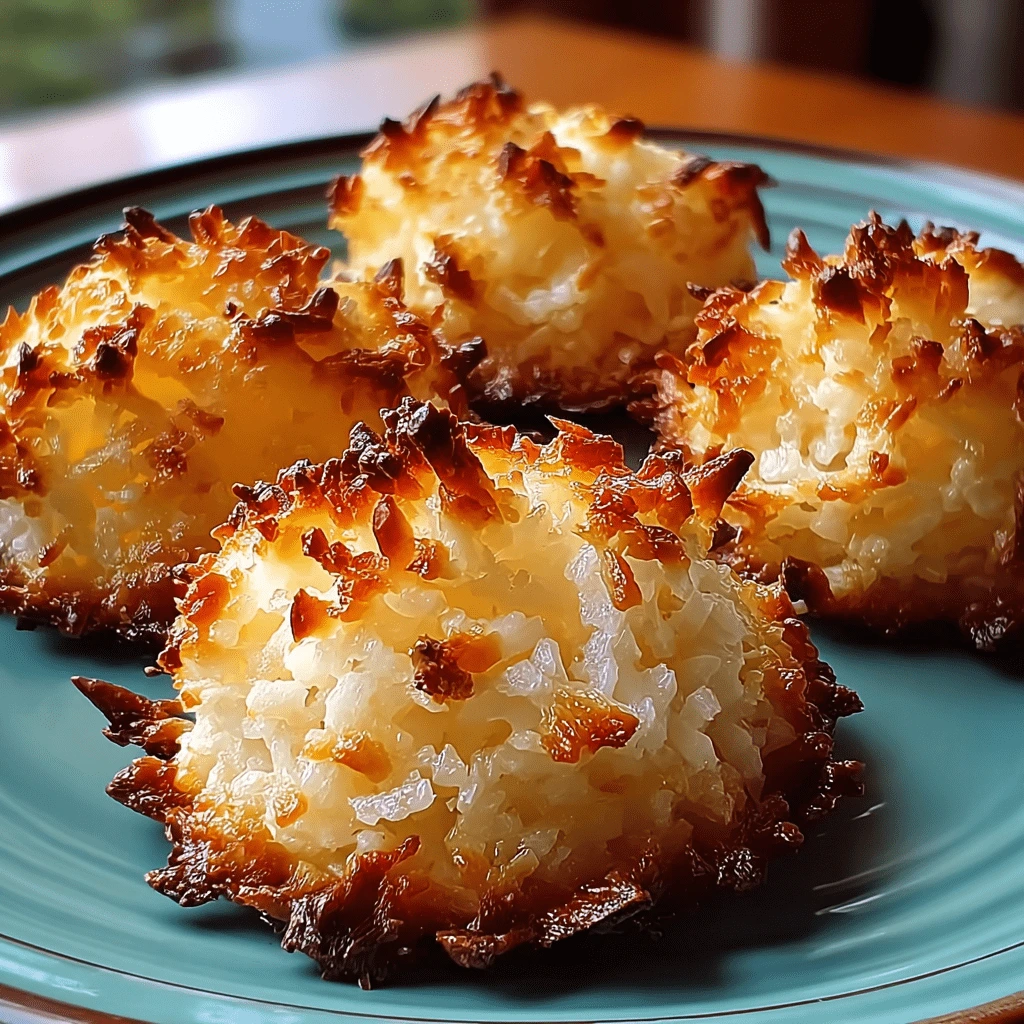
❓ FAQs – people also ask
What is the difference between a macaroon and a macaron?
Macaroons are chewy coconut-based cookies, while macarons are delicate meringue sandwich cookies made with almond flour. They differ in texture, ingredients, and preparation.
Do coconut macaroons need to be refrigerated?
Not necessarily. If kept in an airtight container at room temperature, they stay fresh for up to 5 days. Refrigeration can extend shelf life but may alter texture slightly.
Can I make coconut macaroons without eggs?
Yes, use aquafaba (the liquid from canned chickpeas) as a vegan alternative to egg whites.
Why are my coconut macaroons too dry or too wet?
Dry macaroons are often overbaked, while overly wet ones may result from excess egg white or under-mixed batter.
How do you keep macaroons from spreading?
Measure ingredients precisely and don’t overmix. Chilling the dough slightly can also help them hold shape.
Are coconut macaroons gluten-free?
Yes, as long as you substitute the all-purpose flour with a gluten-free flour blend. Many traditional recipes are naturally gluten-free.
Can you use sweetened condensed milk in place of egg whites?
Yes, though it creates a different texture — denser and sweeter. This version is more traditional and uses egg whites instead.
For more on cookie types and techniques, explore Wikipedia’s guide to cookies.
PrintCoconut Macaroons
These first-place coconut macaroons are delightfully chewy, golden cookies with a crisp exterior and a moist center. Made with only a handful of ingredients, they’re naturally gluten-free, easy to make, and perfect for gifting, holidays, or everyday snacking.
- Prep Time: 10 minutes
- Cook Time: 20 minutes
- Total Time: 30 minutes
- Yield: 18–20 macaroons 1x
- Category: Dessert
- Method: Baked
- Cuisine: American
Ingredients
1 1/3 cups sweetened shredded coconut
1/3 cup granulated sugar
2 tablespoons all-purpose flour (substitute with gluten-free flour if needed)
1/8 teaspoon salt
2 large egg whites
1/2 teaspoon pure vanilla extract
Instructions
Step 1: Preheat Oven
Preheat your oven to 325°F (163°C). Line a baking sheet with parchment paper or lightly grease it.
Step 2: Mix Dry Ingredients
In a medium bowl, combine:
-
1 1/3 cups sweetened shredded coconut
-
1/3 cup sugar
-
2 tablespoons all-purpose flour
-
1/8 teaspoon salt
Stir together until evenly mixed.
Step 3: Add Wet Ingredients
In a small bowl, whisk:
-
2 large egg whites
-
1/2 teaspoon vanilla extract
Pour this mixture into the dry ingredients. Stir until fully combined. The mixture should be moist enough to hold together but not runny.
Step 4: Shape the Macaroons
Using a teaspoon or a small cookie scoop, drop rounded mounds of dough onto your prepared baking sheet, spacing them about 1 inch apart.
Step 5: Bake
Bake in the preheated oven for 18–20 minutes, or until the tops are lightly golden brown and the edges start to crisp.
Step 6: Cool
Remove from oven and let the macaroons cool on the baking sheet for 5 minutes. Transfer to a wire rack to cool completely.
Notes
-
Texture Tip: Don’t overmix or overbake. The center should remain moist and chewy.
-
Flavor Variations:
-
Add 1 tsp lemon or orange zest for a citrusy twist.
-
Dip cooled cookies in melted chocolate for a decadent finish.
-
Fold in mini chocolate chips or chopped almonds for texture.
-
-
Storage:
-
Store in an airtight container at room temperature for up to 5 days.
-
Freeze for up to 3 months. Reheat in the oven to refresh texture.
-
